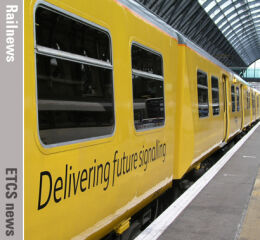Posted 9th December 2022 | 2 Comments
Rail minister sees ETCS progress on East Coast route

Rail minister Huw Merriman has visited King’s Cross station in London to see progress with the installation of digital signalling on the southern section of the East Coast Main Line.
During the past year the programme to introduce the European Train Control System has seen newly-equipped trains used on the Northern City Line between Finsbury Park and Moorgate, while the first retrofitted passenger trains have been tested at the upgraded Rail Innovation and Development Centre. More rolling stock will be fitted soon, including suburban passenger trains and freight locomotives.
Almost 3,000 drivers will be trained to work with information on a monitor in the cab instead of from signals by the lineside, and there are also plans to fit ETCS on those steam locomotives which are approved for special runs on the main line.
The past year has also seen government approval of the Full Business Case for the project, which is supported by over £1 billion of further investment.
The rail minister was shown the project during his visit to King’s Cross yesterday, when he said: ‘It has truly been a year of breakthrough delivery on our East Coast Digital Programme, from the commissioning of new signalling to the testing of trains.’
Network Rail’s director, Industry Partnership for Digital Railway, Toufic Machnouk, said: ‘We are creating the future railway. We are pushing the boundaries with our collaboration across the industry, and demonstrating what the industry can achieve when working together.’
![]()
Reader Comments:
Views expressed in submitted comments are that of the author, and not necessarily shared by Railnews.

david C Smith, Bletchley
Thanks to Ed. for the details re. high( er ) speeds on ECML.
A query in my mind is to compare potential gains and costs at different distances from London. Manchester Piccadilly is 189 miles , compared to 270 miles to / from King's Cross to Newcastle Central. Current timings for the Manchester service are around 2 hrs 10 mins, with a corresponding statistic for Newcastle of around 2 hrs 50 mins.
It seems it is generally accepted that timings over 3 1/2 hours can only expect up to around 30% of the market, whilst those under 2 1/2 hours typically 80 + % ., implying a steeply rising graph in between. This, arising from competitiveness with aviation and from day - return potential, implies that further time reduction on the Manchester services could produce relatively little further market gain , whilst LGV type additional speed - up on the ECML could still give significant ridership increase.
One wonders whether any HS2 project might have been better routed on an east coast alignment , from the above and from potentially lower construction costs , too.
The distribution of population and industry seems to point to the WCML as the country's premier mixed traffic line, with the ECML as the "racetrack to the North ( including Scotland) ". As for WCML capacity considerations, there might well have been increase possible largely based on the ex- Great Central route ( still a working railway south of Calvert ) as a freight route from Nuneaton to Neasden , for a far lower cost.
HS2 is too far advanced now, of course, to change as above .
david C Smith, Bletchley
My understanding is that resignalling could allow those sections of ECML presently at 125mph limit to be upped to 140mph ? I understand this was the original intention when the class 91 / mk 5 trainsets were introduced but it never happened ( political reasons ?).
[There was a trial of 140mph/225km/h on the ECML near Stoke Summit in BR days, which involved a flashing green aspect (proceed at line speed) but HMRI ruled it out until there could be in-cab signalling. The BR Mk4 coaches (not Mk5) were built for 225km/h but GNER later downgraded them for best possible running at 200km/h. The 'Azumas' now on the route have been designed for 225km/h.]